
Mountain Hardwear Vs North Face (The Definitive Guide)
By Unlock Wilderness
7th June 2023
When it comes to outdoor gear, Mountain Hardwear and The North Face are two iconic brands that have been providing adventurers with exceptional choices for generations. But which brand deserves a spot in your closet and backpack? While both have made a name for themselves in the world of outdoor apparel, there are some remarkable differences in design, quality, and price range that could sway your decision.
So, if you’re in the market for a sturdy, weather-resistant jacket or coat and you can't decide between Mountain Hardwear and The North Face, we've got your back. In this article, we'll take a deep dive into the similarities and differences between the two brands to help you decide which one is the perfect fit for your next adventure. Let's get into it!
This post contains affiliate links; as an Amazon Associate we earn commission from qualifying purchases.
Mountain Hardwear Vs North Face
Brand Overviews
When it comes to outdoor apparel and equipment, Mountain Hardwear and North Face are two of the biggest names in the game. While they both have a reputation for producing high-quality gear, they do differ in a few key ways.
Let's start with Mountain Hardwear. Founded in 1993 by a group of former employees of Sierra Designs, the company started out by producing innovative outdoor gear that was specifically designed to withstand extreme weather conditions. Over the years, Mountain Hardwear has become known for its technical clothing and equipment, with a focus on climbing and alpine pursuits.
On the other hand, North Face is an older brand, having been founded in 1966. Originally a retailer of skiing and camping equipment, the company expanded into producing its own line of outdoor gear in the late 1960s. Now, North Face is known for its broad range of outdoor clothing and equipment, catering to a wide variety of outdoor activities such as hiking, skiing, and camping.
While both brands have a focus on producing durable, high-quality equipment, there are some key differences between the two. Mountain Hardwear tends to focus on producing highly technical gear with a specific end use in mind, whereas North Face has a more broad approach, producing gear for a wider range of outdoor activities. Additionally, Mountain Hardwear tends to be geared towards the more hardcore outdoor enthusiast, whereas North Face is more accessible to the average outdoor enthusiast.
Ultimately, the choice between Mountain Hardwear and North Face comes down to personal preference. Understanding the brand ethos and target market can help guide your decision, but at the end of the day, it's important to choose the gear that suits your needs and preferences.
Materials and Technology
When it comes to outdoor apparel brands, Mountain Hardwear and North Face are two of the top contenders in the game. Both are known for their high-quality materials and advanced technologies, which make their jackets some of the best on the market. But how do they compare when it comes to the details? In this section, we're going to take a closer look at the materials and technology used by each brand in their jacket production.
First off, let's talk about insulation. Both Mountain Hardwear and North Face use synthetic materials for their jackets, which is ideal for outdoor activities. Synthetic insulation is more resistant to moisture and dries quickly, which is crucial when you're out in the elements. North Face uses a proprietary insulation called ThermoBall, which mimics down's warmth-to-weight ratio while still being compressible. Mountain Hardwear, on the other hand, uses a variety of synthetic insulations such as Thermal.Q Elite, which is designed to keep you warm in the coldest of conditions.
Moving on, waterproofing is another vital aspect of any outdoor jacket. Both brands utilize advanced technologies to keep you dry, but North Face's DryVent system has become somewhat of an industry standard. It is a waterproof and breathable membrane that is designed to keep water out while allowing sweat to escape. Mountain Hardwear uses a similar technology called Dry.Q, which is equally as effective. However, it's important to note that both DryVent and Dry.Q have different levels of waterproofing, so it's worth doing some research to determine which option is best for your needs.
Breathability is another key factor to consider when it comes to jacket technology. You want a jacket that can keep you warm and dry while also allowing sweat to escape. Both Mountain Hardwear and North Face offer breathable options, with North Face's Ventrix technology being one of the most advanced on the market. It features small perforations that open and close with movement, allowing for optimal breathability. Mountain Hardwear's Conduit fabric also offers excellent breathability, making it a great option for high-intensity activities.
Finally, let's talk about overall durability. A jacket that can withstand the elements and last for years to come is worth its weight in gold. Both Mountain Hardware and North Face are known for using robust materials that can stand up to tough conditions. Mountain Hardwear's Ghost Whisperer jacket, for example, is made from a lightweight but incredibly durable fabric. Similarly, North Face's Summit L3 Down Hoodie is built to last and has been put to the test in some of the harshest conditions in the world.
So, which brand comes out on top when it comes to materials and technology? It's a tough call, as both Mountain Hardwear and North Face offer an array of advanced features and high-quality materials. Ultimately, it comes down to personal preference and the specific needs of your outdoor activities. By weighing the pros and cons of each brand's technology, you'll be able to make an informed decision that will keep you warm, dry, and comfortable on your next outdoor adventure.
Jacket Styles
When it comes to outdoor gear, having the right jacket can make all the difference. That's why we're taking a deep dive into the different styles of jackets offered by Mountain Hardwear and North Face – two major players in the outdoor apparel industry.
Let's start with insulated parkas – these are the big guns, designed to keep you warm in even the harshest conditions. Both brands offer top-of-the-line parkas with high-fill down insulation and waterproof exteriors. However, Mountain Hardwear's parkas tend to have a more technical look, with sharp lines and bold color-blocking, while North Face's parkas have a more classic aesthetic. If you're looking for a parka that blends form and function, Mountain Hardwear might be the way to go. If you want something that looks more timeless, North Face has some great options.
Not every situation calls for a heavy-duty parka, though. Sometimes all you need is a lightweight windbreaker to keep the chill off. Both brands offer windbreakers, but again, the styles differ slightly. Mountain Hardwear's windbreakers tend to have a more athletic vibe, with streamlined designs and stretchy materials. North Face's windbreakers come in a wider range of styles, from pullover half-zips to full-zip jackets with hoods. If you want a windbreaker that can transition from outdoor workouts to everyday wear, Mountain Hardwear might be your go-to. If you need something versatile enough to throw on for any occasion, North Face has options for you.
Of course, no jacket collection is complete without a mid-layer fleece. These cozy pieces are perfect for layering under a shell jacket for added warmth, or wearing on their own during mild weather. Again, both Mountain Hardwear and North Face have some great options. Mountain Hardwear's fleeces tend to be more technical, with features like zippered pockets and thumb loops for added functionality. North Face's fleeces come in a wide range of colors and styles, from basic zip-ups to pullovers with stylish detailing. If you're looking for a mid-layer that can serve as a standalone piece, North Face might be the brand for you. If you need something more technical for your outdoor pursuits, Mountain Hardwear has you covered.
Ultimately, the right jacket for you will depend on your needs and preferences. Both Mountain Hardwear and North Face offer a wide variety of styles, each with their own unique features and design elements. By exploring the different options, you can determine which brand will best suit your needs and help you tackle whatever adventure comes your way.
Price and Value
When it comes to purchasing a high-quality jacket for your outdoor adventures, you want to find a brand that offers the best combination of affordability and quality. In this section, we will examine the price and value of jackets from Mountain Hardwear and The North Face.
Both brands have a range of jackets that differ in price, but how do you know which one is worth investing in? One factor that can help you decide is the warranty that each brand offers. In terms of warranty, The North Face offers a lifetime warranty on their products, while Mountain Hardwear offers a limited lifetime warranty. This means that if something goes wrong with your jacket because of a defect in workmanship or materials, you can get it repaired or replaced free of charge.
Another key factor is customer service. In our research, we found that both brands have excellent customer service, with representatives who are knowledgeable and helpful. However, The North Face has a more extensive network of customer service centers, making it easier to get help if you need it.
Finally, we come to reputation. Both Mountain Hardwear and The North Face are renowned for their high-quality materials and attention to detail. They are both highly respected brands in the outdoor industry, with a reputation for producing durable jackets that can withstand even the harshest conditions.
When it comes down to it, both brands offer great value for money in terms of the quality of their jackets and the warranties they offer. However, when it comes to customer service and reputation, The North Face comes out on top. Ultimately, the decision between these two brands comes down to your personal preferences and priorities. Whatever choice you make, you can be confident that you are getting a high-quality jacket that will serve you well for years to come.
Mountain Hardwear Vs North Face Men's Insulated Jackets
When it comes to Men's Insulated Jackets, both Mountain Hardwear and The North Face have impressive offerings, but each has its unique selling points.
Mountain Hardwear's Ghost Whisperer/2™ Jacket is a sustainable option for environmentally conscious adventurers. The jacket is made from recycled materials and responsibly sourced down insulation, making it a great choice for those who want to minimize their carbon footprint. The first baffle at both cuffs that is filled with synthetic insulation to prevent cuffs from wetting out is a standout feature. Additionally, being lightweight and highly packable means that it’s great for outdoor enthusiasts who are constantly on the go.
On the other hand, The North Face's ThermoBall™ Eco Jacket 2.0 boasts advanced insulation and a sleek design. The ThermoBall™ Eco insulation system is ideal for those who want to stay warm in wet conditions, a crucial feature for mountain climbing and alpine pursuits. The jacket is also made from 100% recycled materials, making it an eco-friendly choice for consumers.
Comparing the two jackets, it's clear that Mountain Hardwear's Ghost Whisperer/2™ Jacket is a better choice for those looking for a lightweight, highly packable option with exceptional sustainability features. Meanwhile, The North Face's ThermoBall™ Eco Jacket 2.0 is perfect for those looking for advanced insulation technology and a sleek, stylish jacket that performs well in a variety of outdoor activities. Ultimately, it depends on the individual's needs and priorities, but both brands offer excellent Men's Insulated Jackets that cater to a wide range of activities and environmental concerns.

Ghost Whisperer/2™ Jacket by Mountain Hardwear
Our rating: ★★★★★
Price: $$$$
Stay warm and eco-friendly on your outdoor adventures.
What makes it special? This jacket is made with completely recycled face and trim fabrics, and responsibly sourced, RDS-certified down insulation, making it an eco-friendly choice for any outdoor adventurer. But don't let its sustainability fool you, this jacket is designed to keep you warm in even the coldest of climates. The ultra-lightweight ripstop fabric and 800-fill RDS®-certified down insulation ensure that you stay warm without weighing you down. One of the unique features of this jacket is the first baffle at both cuffs that is filled with synthetic insulation to prevent cuffs from wetting out. This is a game-changer for those who enjoy outdoor activities in wet and damp conditions. The Ghost Whisperer/2™ Jacket comes with two zippered hand pockets, elastic binding on cuffs to seal in warmth, and a drawcord hem adjustment for a customized fit. Best of all, it's highly packable design stuffs into its own hand pocket with an internal carabiner clip loop, making it easy to bring with you on any adventure.
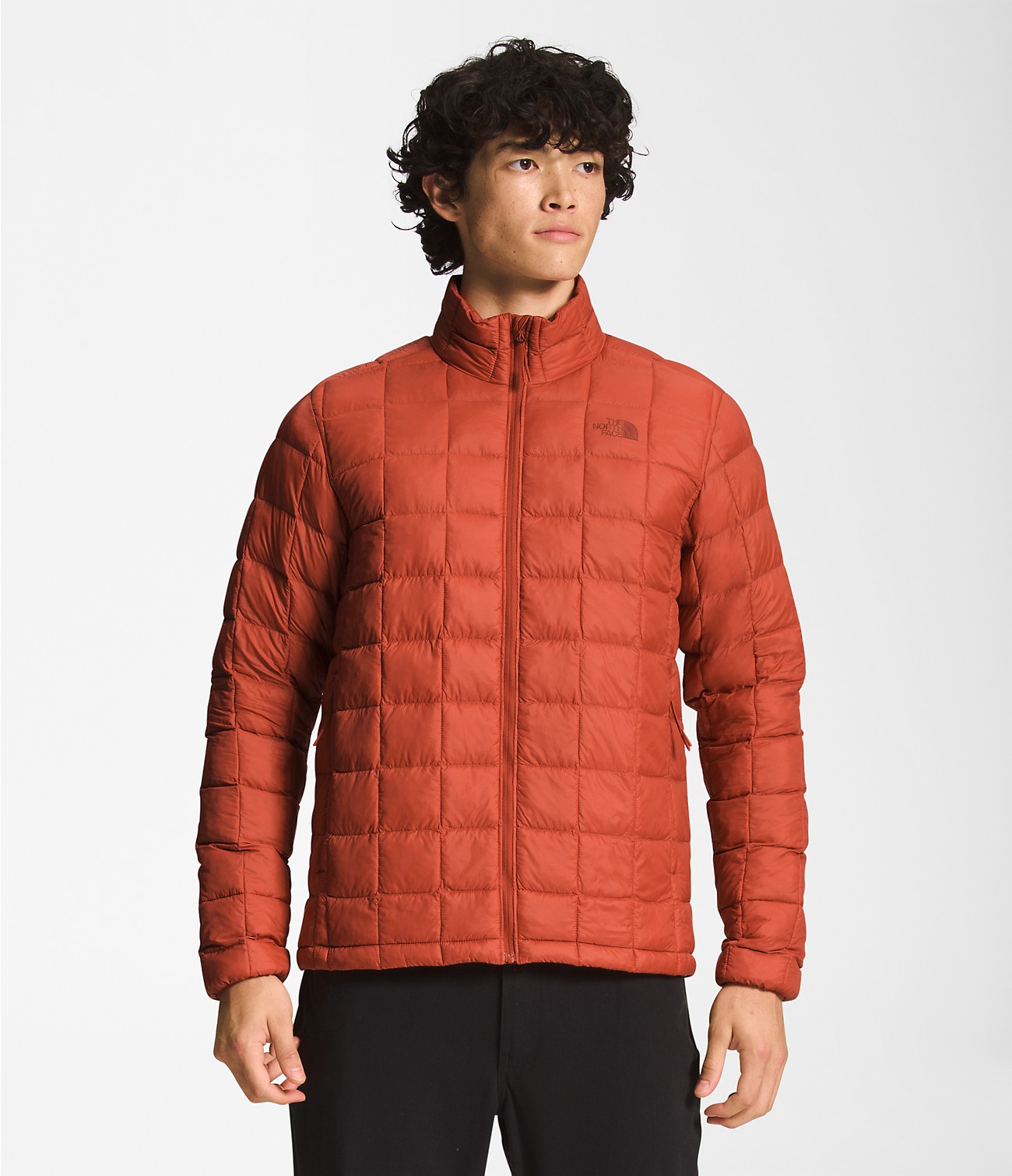
ThermoBall™ Eco Jacket 2.0 by The North Face
Our rating: ★★★★★
Price: $$$$
Sustainable, slim-fit and efficient insulated jacket.
What makes it special? The slim-fit design is perfect for layering and the quilting pattern ensures that the insulation is evenly distributed for maximum warmth. What makes this jacket stand out is the ThermoBall™ Eco insulation, which keeps you warm even when wet! This is crucial when exploring mountainous regions where sudden weather changes are common, and you don't want to be held back by a damp jacket. The jacket is made from 100% recycled materials, making it an environmentally conscious choice without sacrificing durability. It's lightweight and can easily be packed away when not in use. The reverse-coil center front zip, concealed, secure-zip hand pockets, and stowable chest pocket make for a streamlined and practical design.
Mountain Hardwear Vs North Face Men's Parkas
When it comes to Men's Parkas, both Mountain Hardwear and The North Face have offerings that are worth considering. Mountain Hardwear's Absolute Zero™ Parka is a high-altitude climbing parka that is designed to withstand the harshest conditions atop the world's highest peaks. On the other hand, The North Face's HMLYN Down Parka is a more versatile option that is suitable for both high alpine expeditions and everyday use.
If you're in the market for a parka that can handle extreme weather conditions, then the Absolute Zero™ Parka is the way to go. With its 800-fill RDS-Certified Allied Down and welded, waterproof construction, this parka is built to keep you warm and dry in even the most challenging environments. Its Pertex 20D Diamond Fuse Ripstop shell fabric and Pertex® 50D reinforced panels at elbows provide additional durability, ensuring that the Absolute Zero™ Parka will last for years to come.
On the other hand, if you're looking for a more versatile parka that can be used in a variety of settings, then the HMLYN Down Parka is a solid choice. It features highly wind-resistant WindWall™ fabric and a non-PFC DWR finish for added water repellency. With its 550 fill goose down and adjustable hood, cuffs, and hem, the HMLYN Down Parka provides ample insulation and customization options to keep you comfortable in a range of weather conditions. Additionally, its relaxed fit and stylish design make it suitable for both outdoor activities and everyday wear.
Overall, both Mountain Hardwear and The North Face offer high-quality Men's Parkas that are built to last and keep you warm. The decision between the two comes down to personal preference and the intended use of the parka. If you're planning on embarking on an extreme high-altitude adventure, then the Absolute Zero™ Parka is an excellent choice. But if you're looking for a more versatile option that's suitable for everyday wear as well as outdoor activities, then the HMLYN Down Parka is a solid choice.
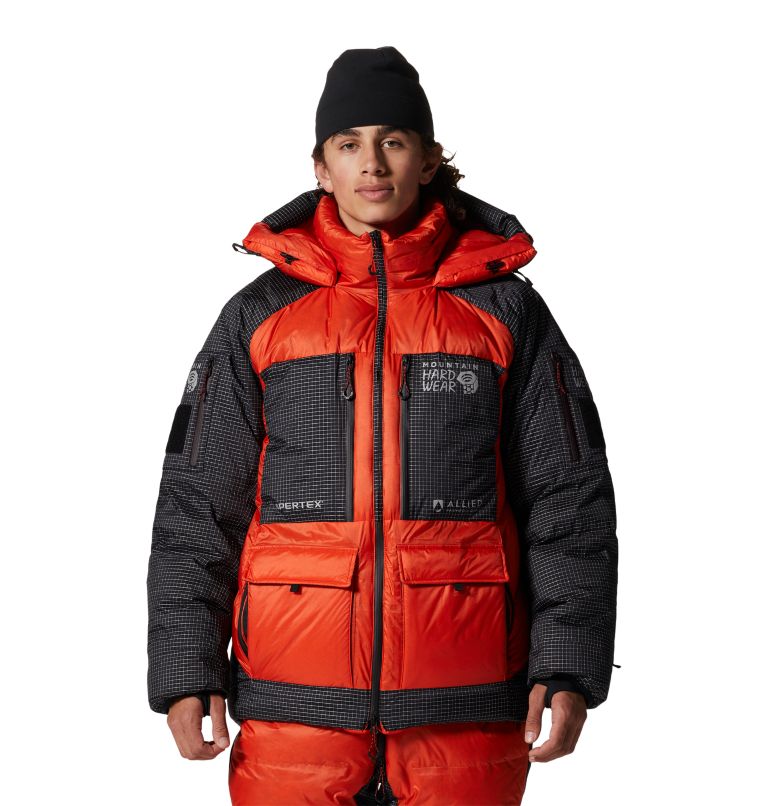
Absolute Zero™ Parka by Mountain Hardwear
Our rating: ★★★★★
Price: $$$$+
Reach new heights with the ultimate high-altitude parka.
What makes it special? This parka is so reliable that even the elite athlete and big mountain guide, Garrett Madison, worked with Mountain Hardwear to ensure that the evolution of this welded, waterproof construction continues to withstand the harshest conditions atop the world's highest peaks. The Absolute Zero™ Parka is perfect for alpine climbing. The Pertex 20D Diamond Fuse Ripstop shell fabric ensures durability and protection from the elements. The welded box baffle construction with 800-fill RDS-Certified Allied Down is designed to keep you warm and comfortable even in the harshest weather conditions. The low profile, insulated fixed hood with drawcord allows for quick adjustments to protect you from the cold. The Pertex® 50D reinforced panels at elbows and extended underarm vent zippers come in handy when you need to move around while still keeping warm. What's more, its internal brace system, cuff gasket with thumb loops to keep out snow and wind, and watch window for easy monitoring ensure that you are fully equipped and comfortable at all times.
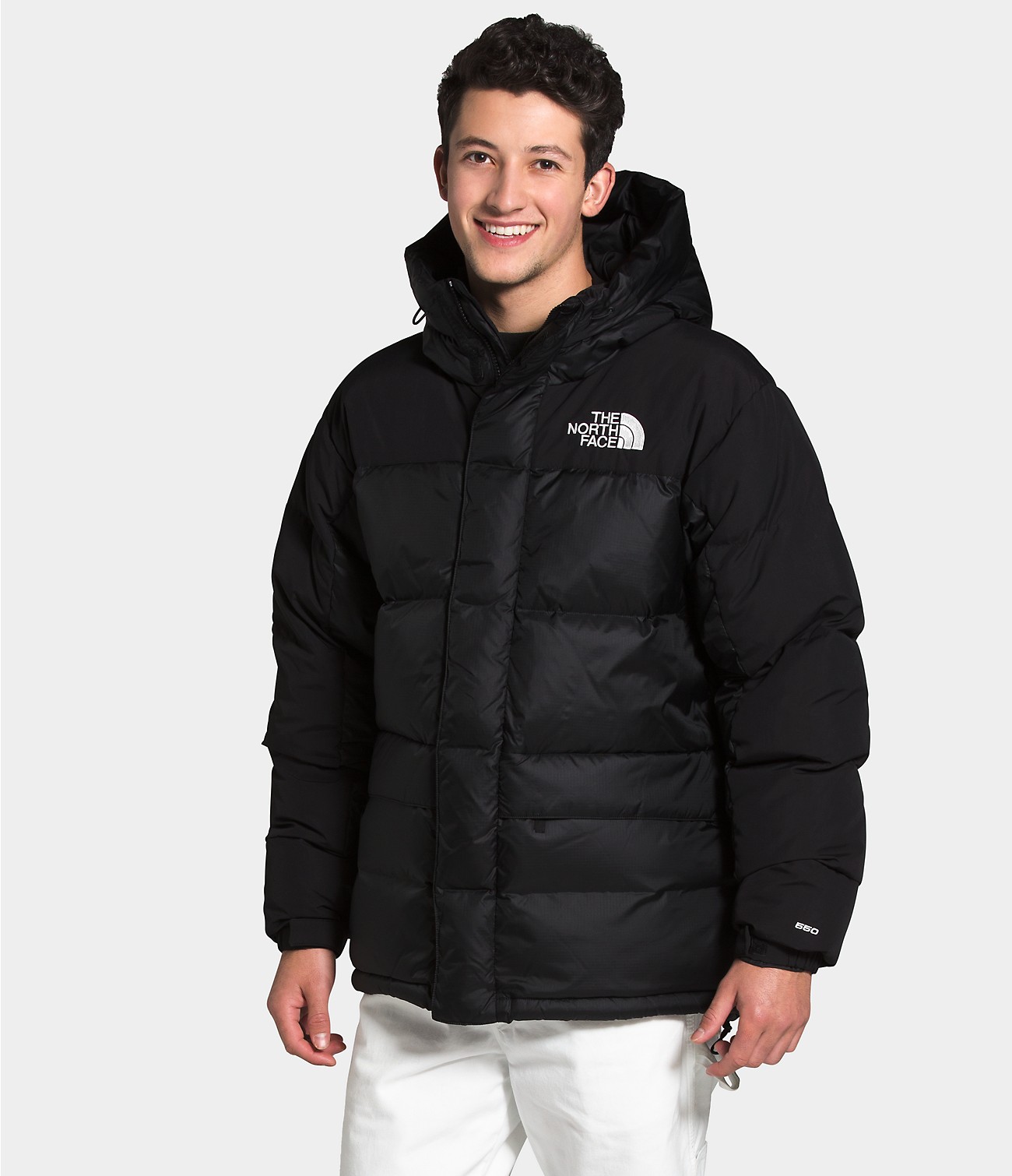
HMLYN Down Parka by The North Face
Our rating: ★★★★★
Price: $$$$
The ultimate high-altitude parka.
What makes it special? Inspired by the original Himalayan Down Jacket, this parka is packed with features that make it suitable for both high alpine expeditions and everyday use. The HMLYN Down Parka is made with highly wind-resistant WindWall™ fabric and features a non-PFC DWR finish for added water repellency. The 550 fill goose down provides ample insulation to keep you warm in cold temperatures. The attached, three-piece hood with a drawcord and cord locks allows for adjustability, ensuring a comfortable fit. The stormflap with a hook-and-loop closure covers the center front zip, providing an additional layer of protection against the elements. This parka also boasts ample storage options with two top-entry, secure-zip front patch pockets, side-entry, secure-zip hand pockets, and a secure-zip internal chest pocket. The adjustable hook-and-loop cuff tabs and drawcord at the hem allow for further customization to suit your needs. The overlay on the yoke, sleeve panels, and cuffs provides extra durability, ensuring the HMLYN Down Parka will withstand years of use.
Mountain Hardwear Vs North Face Men's Waterproof Jackets
When it comes to choosing between Mountain Hardwear and The North Face for men's waterproof jackets, it's important to consider your individual needs. While both brands offer excellent options, Mountain Hardwear's Stretch Ozonic™ Jacket is a great choice if sustainability is important to you, with its 100% recycled fabric, while the The North Face's Dryzzle FUTURELIGHT™ Jacket offers excellent breathability and a range of adjustable features that make it perfect for outdoor activities like hiking and camping. Ultimately, it's up to you to decide which brand's jacket is the best fit for your needs based on features, style, and brand values.
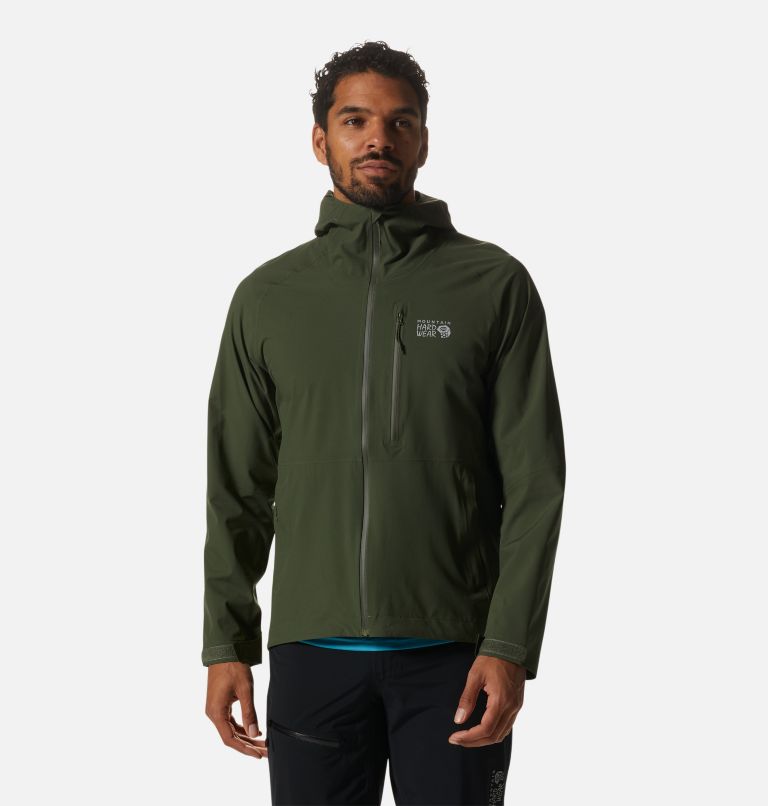
Stretch Ozonic™ Jacket by Mountain Hardwear
Our rating: ★★★★★
Price: $$$$
Reliable and sustainable weather protection for outdoor adventures.
What makes it special? This jacket is the perfect choice for anyone looking for protection against wet weather during outdoor activities such as hiking, camping, and backpacking. It’s made from 100% recycled fabric and features Dry.Q 2.5-layer stretch ripstop fabric, which is super soft and quiet. One of the great features of the Stretch Ozonic™ Jacket is its highly adjustable hood and underarm zip vents, which make it possible to customize the jacket’s ventilation and temperature control to suit your needs. It also features a zippered chest pocket and two zippered hand pockets, allowing you to easily store your essentials without fear of them getting wet. In addition to being incredibly protective and functional, the Stretch Ozonic™ Jacket is also highly packable and can easily be packed into its own hand pocket with the internal carabiner clip loop. And with its updated fit, this jacket is sure to become a tried-and-true favorite in your outdoor gear collection.
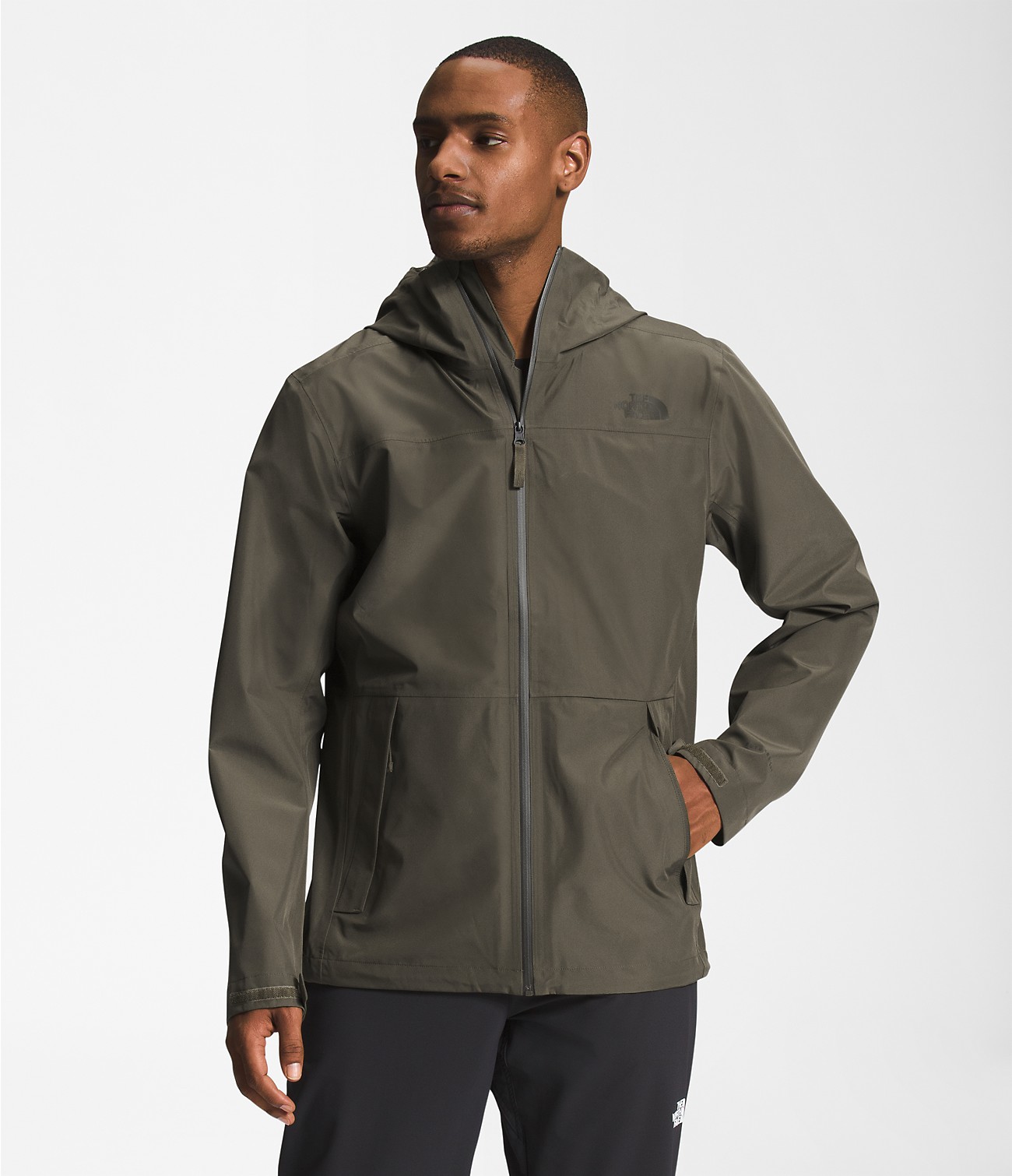
Dryzzle FUTURELIGHT™ Jacket by The North Face
Our rating: ★★★★★
Price: $$$$
Stay dry in any weather with this eco-friendly jacket.
What makes it special? This slim-fit jacket features a breathable-waterproof, seam-sealed FUTURELIGHT™ 3L shell that's both warm and comfortable thanks to its soft stretch-woven face and stretch-knit backer. Plus, with a non-PFC DWR finish, you'll stay dry even in the heaviest rain. The adjustable, three-piece hood and reverse-coil, full-length center front zip with a chin guard ensure that you're protected from the elements, while the three zip-secure pockets give you plenty of space to store your essentials. And when the weather clears up, simply stash the Dryzzle FUTURELIGHT™ Jacket in the internal stow bag for easy transport. But what really sets this jacket apart is its commitment to sustainability. The body is made with recycled polyester and nylon, so you can feel good about your purchase knowing that you're doing your part to protect the environment.
Mountain Hardwear Vs North Face Women's Insulated Jackets
When it comes to women's insulated jackets, both Mountain Hardwear and The North Face offer great options, but they differ in their approach to sustainability and style.
Mountain Hardwear's Ghost Whisperer/2™ Hoody is a great choice for those looking for a sustainable and eco-friendly option. It is made with recycled face and trim fabrics, and responsibly sourced, RDS-certified down insulation. This brand has a focus on sustainability which is highlighted in the Ghost Whisperer/2™. If you're into rock climbing, backpacking or other outdoor activities that require warmth while being on the move, then this jacket is a fantastic choice. It is ultra-lightweight, ripstop fabric and elastic binding on the hood and cuffs seals in warmth.
On the other hand, The North Face's ThermoBall™ Eco Hoodie 2.0 is packed with unique features and a style that's perfect for those looking for a sleek jacket. It's a slim-fit jacket that is great at providing warmth even when wet since it features ThermoBall™ Eco insulation, which is perfect for people that live in areas with inconsistent weather conditions. Additionally, the jacket is equipped with 100% recycled fleece, making it great for the environment-conscious. It ensures that every piece is unique and eco-friendly with the implication of its manufacturing process.
Both brands offer lightweight and packable styles that are perfect for traveling and exploring the outdoors. But if you are looking for ultimate sustainability, Mountain Hardwear has more of a focus in this area with the Ghost Whisperer/2™ for eco-friendly adventures. However, The North Face ThermoBall™ Eco Hoodie 2.0 is just as versatile and functional with its slim-fit and innovative quilting pattern, which makes it perfect for those looking for a subtle yet stylish jacket that fits seamlessly with their outdoor lifestyle. Ultimately, the choice between these two brands depends on your style preference, and how much of a priority is sustainability and unique features when making your purchase.
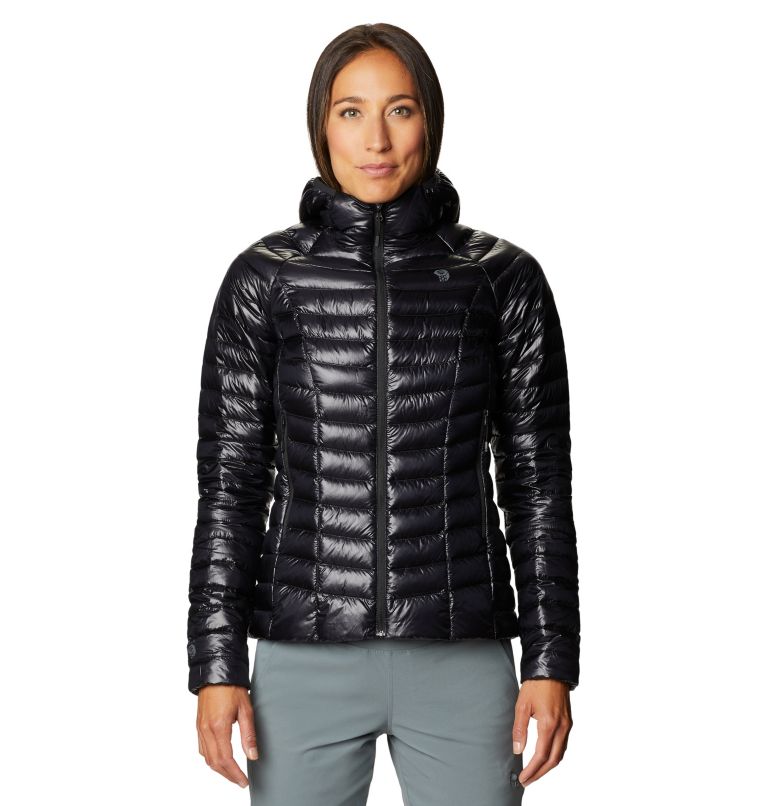
Ghost Whisperer/2™ Hoody by Mountain Hardwear
Our rating: ★★★★★
Price: $$$$
Sustainable warmth for outdoor adventures.
What makes it special? Not only does it keep you warm during cold weather, but it is also sustainably made. This hoody is a great alternative to the traditional down hoody because it uses recycled face and trim fabrics, and responsibly sourced, RDS-certified down insulation. Its ultra-lightweight ripstop fabric makes it perfect for various outdoor activities, such as backpacking, hiking, and even rock climbing. The elastic binding on the hood and cuffs helps seal in warmth, and the first baffle at both cuffs is filled with synthetic insulation to prevent cuffs from getting wet. Moreover, the Ghost Whisperer/2™ is highly packable and can be stuffed into its own hand pocket, making it easy to carry around while traveling. You can simply clip it onto your backpack with the internal carabiner clip loop, and you're good to go. The two zippered hand pockets also provide ample storage for your essentials. Plus, the Responsible Down Standard certifies the down against animal welfare requirements, making it a guilt-free purchase.
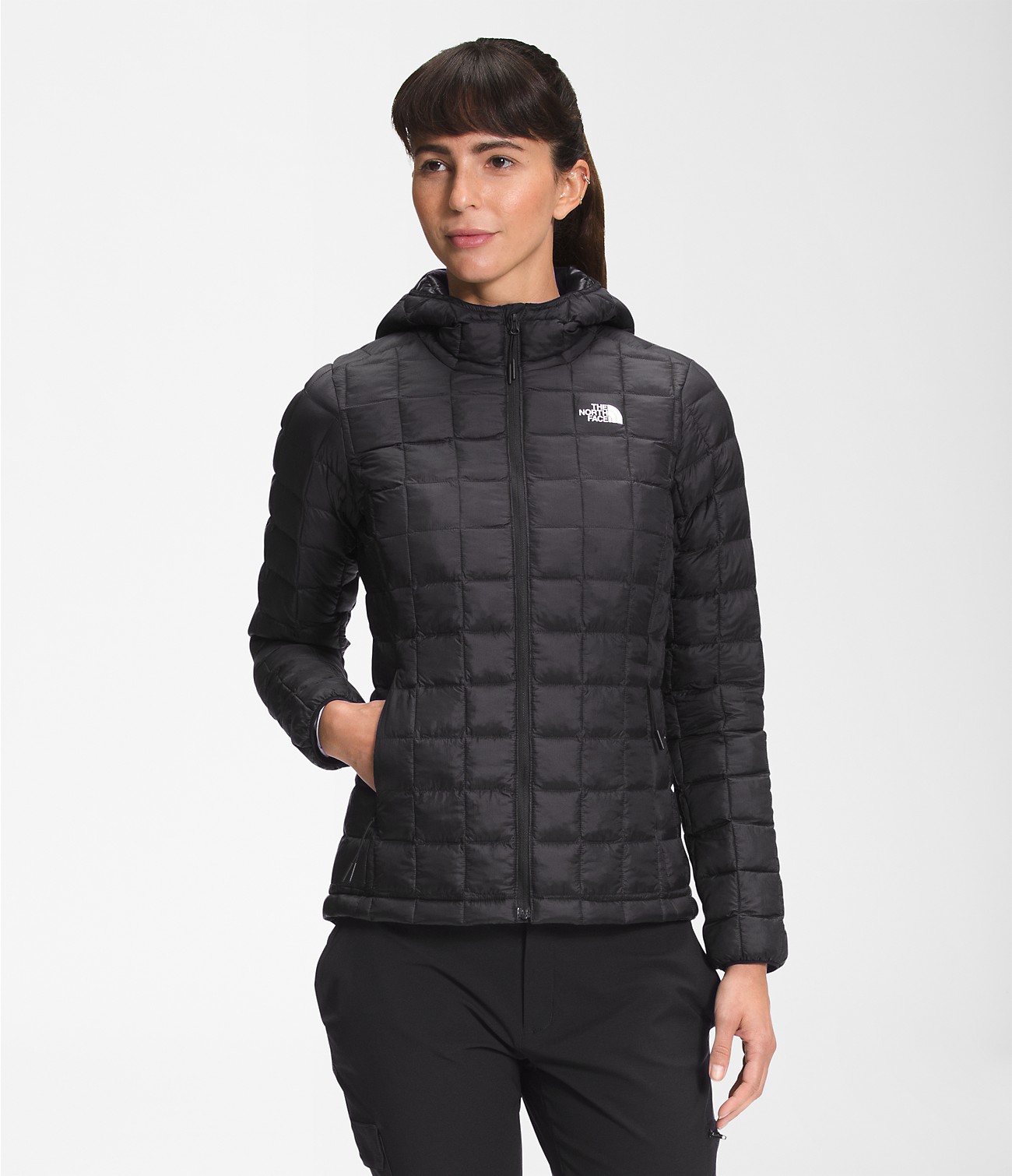
ThermoBall™ Eco Hoodie 2.0 by The North Face
Our rating: ★★★★★
Price: $$$$
Sustainable insulation for adventurers.
What makes it special? This jacket is made with 100% recycled fabrics and fill, making it not only a stylish and functional choice for your next outdoor adventure, but an eco-friendly one as well. The slim-fit design of the ThermoBall™ Eco Hoodie 2.0 is both flattering and comfortable, with an innovative 2x2 quilt pattern that adds extra insulation without adding bulk. The jacket also features ThermoBall™ Eco insulation, which provides warmth even when wet, making it a great choice for cold and damp weather. But what really sets this jacket apart is its packability. It stows neatly in its own chest pocket, making it easy to toss in your backpack or travel bag for those unpredictable weather changes on the go. The hood is also a great addition, providing extra protection from the elements when needed. And the concealed, secure-zip hand pockets are a thoughtful touch, keeping your valuables safe and secure while you explore.
Mountain Hardwear Vs North Face Women's Parkas
When it comes to women's parkas, both Mountain Hardwear and The North Face have plenty to offer. If you're trying to decide between these two brands, there are a few key things to consider.
First and foremost, both brands prioritize functionality and performance. The Mountain Hardwear Phantom Parka is an excellent choice for anyone looking for a high-performance jacket that can handle extreme environments. It features ultralight Pertex shell fabric, RDS-certified down insulation, and a helmet-compatible insulated hood for maximum warmth and protection. If you're into alpine climbing or rock climbing, this parka is designed specifically for those activities.
Meanwhile, The North Face Arctic Parka offers a tailored fit and chic design, making it a great option for anyone who wants to stay warm while looking fashionable. It features a waterproof, breathable DryVent shell, 550-fill goose down insulation, and 150g Heatseeker Eco insulation, which provides excellent warmth-to-weight ratio. This parka also has plenty of pockets, a storm flap, and a two-way center front zipper for maximum versatility and convenience.
Ultimately, choosing between these two brands will depend on your specific needs and preferences. If you're looking for a jacket that can handle extreme environments, Mountain Hardwear may be the way to go. But if you want something stylish and versatile, The North Face is an excellent choice. No matter which brand you choose, however, you can rest assured that you'll be getting a high-quality women's parka that will keep you warm and comfortable in a variety of conditions.
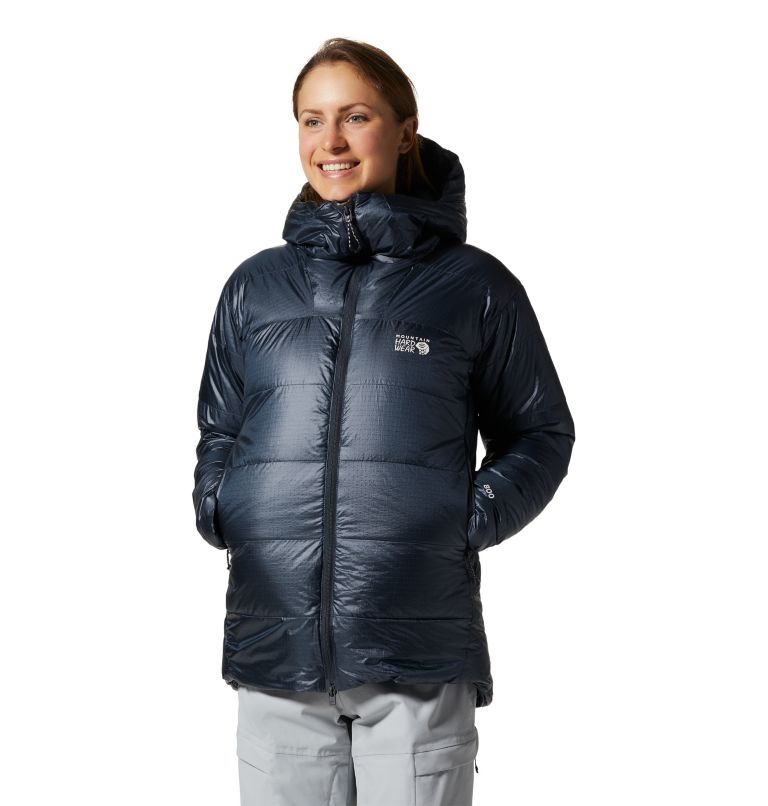
Phantom™ Parka by Mountain Hardwear
Our rating: ★★★★★
Price: $$$$
Stay warm in extreme environments with this high-performance parka.
What makes it special? This jacket is perfect for alpine climbing, rock climbing, and any other outdoor activity where you need to stay warm and comfortable in bone-chilling temperatures. One of the standout features of this parka is the ultralight Pertex® 20D Diamond Fuse ripstop shell fabric with a DWR finish. This fabric is incredibly durable and can withstand harsh conditions, so you won't have to worry about tearing or ripping the jacket when you're out in the wilderness. The Phantom™ Parka is also filled with 800-fill RDS®-certified down insulation, which provides high-lofting, packable warmth without adding bulk. The box-wall constructed baffles eliminate cold spots, ensuring that you stay warm from head to toe. This parka features a helmet-compatible insulated hood with drawcord adjustment, a two-way center front zipper, and two harness-compatible zippered hand pockets. There's also an interior zippered chest pocket where you can store your phone, keys, or other small items.

Arctic Parka by The North Face
Our rating: ★★★★★
Price: $$$$
The perfect winter parka to keep you warm.
What makes it special? It not only looks sleek and stylish, but it also provides a great warmth-to-weight ratio, thanks to its 550-fill goose down and 150g of Heatseeker Eco insulation. Plus, the waterproof, breathable DryVent 2L shell ensures you stay dry and comfortable in any weather conditions. One of the standout features of the Arctic Parka is its tailored fit – it's designed to flatter your figure without sacrificing functionality. Whether you're running errands around town or hitting the slopes, the rib-knit cuffs and stormflap with hook-and-loop closure will keep you warm and protected. And with covered, secure-zip hand pockets and an internal, media-compatible pocket, you can store all your essentials on the go.
Mountain Hardwear Vs North Face Women's Waterproof Jackets
When it comes to Women's Waterproof Jackets, Mountain Hardwear and The North Face are two brands that offer a wide range of options. While both companies have a reputation for producing high-quality jackets, there are some key differences to consider before making a purchase.
Mountain Hardwear's Minimizer™ GORE-TEX® Paclite Plus Jacket is a standout option. It's incredibly lightweight and packable, making it perfect for backpacking and hiking. The GORE-TEX PACLITE® Plus fabric also provides next-to-skin comfort and durable protection. On the other hand, The North Face's Antora Jacket is made with 100% recycled fabrics and is a stylish yet functional option. It boasts a water-repellent, breathable, and windproof shell and an adjustable hood to keep you protected from the elements.
Mountain Hardwear's jackets tend to have a minimalist design that's focused on functionality. The brand is known for using innovative materials and technology to create garments that meet the needs of serious outdoor enthusiasts. The Minimizer™ GORE-TEX® Paclite Plus Jacket is a prime example of the brand's commitment to producing high-quality outerwear that's both practical and durable.
In contrast, The North Face's jackets often have a more fashion-forward design that's versatile enough to be worn both on and off the trail. The Antora Jacket is an excellent choice for women who want a jacket that can perform well on outdoor adventures while also looking stylish enough to wear around town.
Ultimately, when choosing between Mountain Hardwear and The North Face, it's important to consider your specific needs. If you're looking for a jacket that's practical, lightweight, and focused on performance, Mountain Hardwear might be the better choice. On the other hand, if you want a jacket that's both functional and fashionable, The North Face might be the way to go.
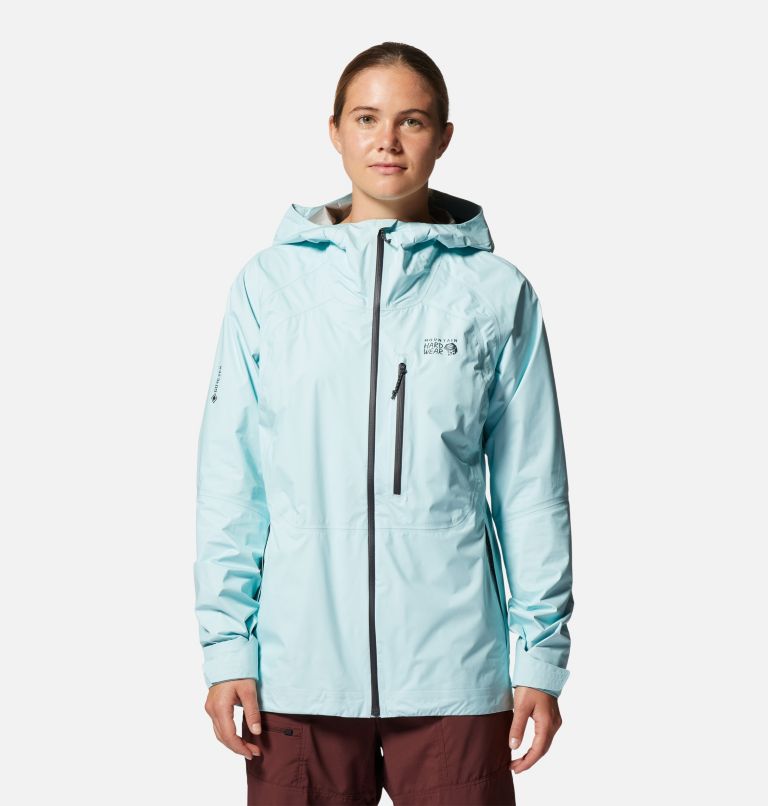
Minimizer™ GORE-TEX® Paclite Plus Jacket by Mountain Hardwear
Our rating: ★★★★★
Price: $$$$
Experience the ultimate lightweight waterproof protection.
What makes it special? This jacket stands out with its ultra-lightweight design that packs down smaller than a beer can. Not only is it perfect for backpacking and hiking, but it's also great for camping and any outdoor adventure in the backcountry. What sets this jacket apart is its waterproof and breathable 2-layer GORE-TEX PACLITE® Plus fabric that provides next-to-skin comfort and durable protection. You won't feel weighed down by bulky rainwear while wearing this jacket. It's incredibly lightweight, coming in at just 8 oz / 225 g (size M), making it easier to carry in your pack. The Minimizer™ GORE-TEX® Paclite Plus Jacket is equipped with adjustable cuffs, an adjustable hood, and a drawcord hem adjustment, making it highly customizable to fit your body and your needs. It also has a zippered chest pocket and two zippered hand pockets, providing ample storage space for your essentials. Perhaps the greatest feature of this jacket is its highly packable design. It stuffs into its chest pocket with an internal carabiner clip loop, so you can easily attach it to your backpack for quick access.
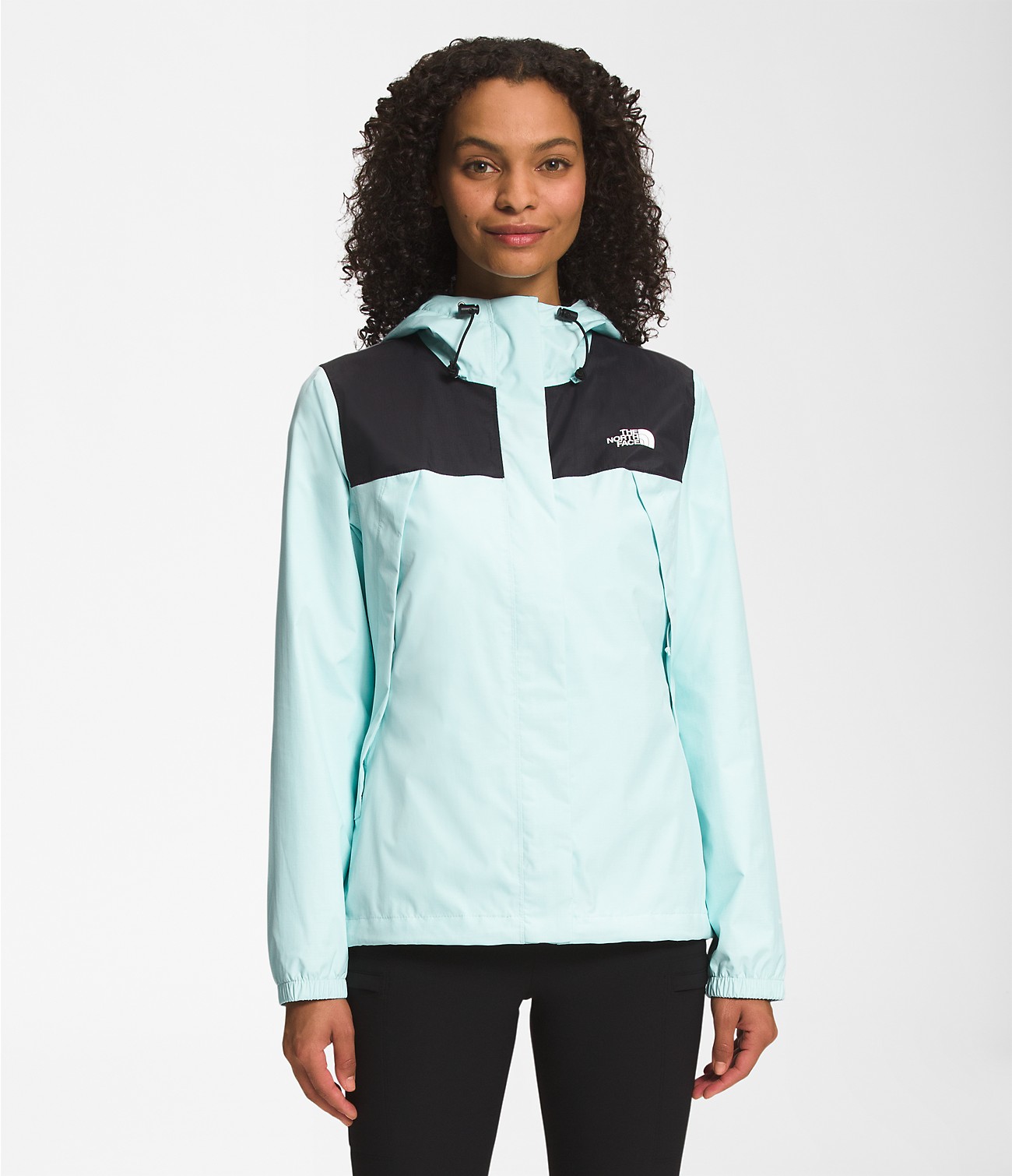
Antora Jacket by The North Face
Our rating: ★★★★★
Price: $$$$
Eco-friendly waterproof jacket for the fashion-forward adventurer.
What makes it special? Not only is it made with 100% recycled fabrics, but it also boasts a water-repellent, breathable, and windproof shell. This means that you'll stay dry, comfortable, and protected from the elements on your next outdoor adventure. The Antora Jacket has a standard fit, which makes it versatile enough to wear over layers during colder weather or by itself during milder weather. Its alpine-style design, along with secure-zip hand pockets, make it a fashionable and functional choice for any outdoor activity. One of the standout features of this jacket is the attached, three-piece hood that can be adjusted with a drawcord and cord locks to fit your head perfectly. The stormflap with a hook-and-loop closure that covers the center front zip ensures that wind and rain won't seep through the zipper. Additionally, the elastic-bound cuffs and internal drawcord with a cord lock at hem provide extra protection and added adjustability.
Final Verdict
In conclusion, when it comes to deciding between Mountain Hardwear and North Face for coats and jackets, there is no clear winner. Both brands offer high-quality products that cater to different needs and preferences.
Mountain Hardwear is ideal for outdoor enthusiasts who prioritize functionality and durability. They offer a wide range of technical jackets designed for extreme conditions, such as mountaineering and skiing. On the other hand, North Face focuses more on style and versatility, with jackets that can be worn both in the city and the wilderness.
Ultimately, the choice between these brands comes down to personal preference and intended use. If you're an avid adventurer who needs a jacket that can withstand harsh weather conditions, Mountain Hardwear may be the better option. However, if you want a jacket that is both fashionable and practical, North Face might be the way to go.
In the end, it's important to remember that both brands have their strengths and weaknesses, and neither is definitively better than the other. So, whether you choose Mountain Hardwear or North Face, rest assured that you'll be getting a dependable and high-quality jacket that will last you for years to come.
Related articles
Arc'teryx vs Mountain Hardwear (The Definitive Guide)
Mountain Hardwear vs Columbia (The Definitive Guide)
Marmot vs Mountain Hardwear (The Definitive Guide)
Mountain Hardwear vs Patagonia (The Definitive Guide)
Rab vs Mountain Hardwear (The Definitive Guide)
Helly Hansen vs North Face (The Definitive Guide)
North Face vs Arcteryx (The Definitive Guide)
North Face vs Fjallraven (The Definitive Guide)
Columbia vs North Face (The Definitive Guide)
Patagonia vs North Face (The Definitive Guide)
North Face vs Tommy Hilfiger (The Definitive Guide)
Nike vs North Face (The Definitive Guide)
Osprey vs North Face (The Definitive Guide)
Salomon vs North Face (The Definitive Guide)
Kathmandu vs North Face (The Definitive Guide)
Jack Wolfskin vs North Face (The Definitive Guide)
Marmot vs North Face (The Definitive Guide)
Canada Goose vs North Face (The Definitive Guide)
Eddie Bauer vs North Face (The Definitive Guide)
Uniqlo vs North Face (The Definitive Guide)
North Face vs Mammut (The Definitive Guide)
Black Diamond vs North Face (The Definitive Guide)
Berghaus vs North Face (The Definitive Guide)
Carhartt vs North Face (The Definitive Guide)
Rei vs North Face (The Definitive Guide)
Merrell vs North Face (The Definitive Guide)
L.L. Bean vs North Face (The Definitive Guide)
Keen vs North Face (The Definitive Guide)
Timberland vs North Face (The Definitive Guide)
Dakine vs North Face (The Definitive Guide)
Haglofs vs North Face (The Definitive Guide)
Deuter vs North Face (The Definitive Guide)
Thule vs North Face (The Definitive Guide)
Karrimor vs North Face (The Definitive Guide)
Superdry vs North Face (The Definitive Guide)
Lululemon vs North Face (The Definitive Guide)
Craghoppers vs North Face (The Definitive Guide)
Stone Island vs North Face (The Definitive Guide)
Barbour vs North Face (The Definitive Guide)
Lands' End vs North Face (The Definitive Guide)
Moncler vs North Face (The Definitive Guide)
Adidas vs North Face (The Definitive Guide)
Montbell vs North Face (The Definitive Guide)
Oakley vs North Face (The Definitive Guide)
Kühl vs North Face (The Definitive Guide)
Napapijri vs North Face (The Definitive Guide)
Cotopaxi vs North Face (The Definitive Guide)
Decathlon vs North Face (The Definitive Guide)
Macpac vs North Face (The Definitive Guide)
Outdoor Research vs North Face (The Definitive Guide)
Spyder vs North Face (The Definitive Guide)
Herschel vs North Face (The Definitive Guide)
Eastpak vs North Face (The Definitive Guide)
Wantdo vs North Face (The Definitive Guide)
Hawke and Co vs North Face (The Definitive Guide)
Woolrich vs North Face (The Definitive Guide)
Geographical Norway vs North Face (The Definitive Guide)
Trespass vs North Face (The Definitive Guide)
Regatta vs North Face (The Definitive Guide)
Burton vs North Face (The Definitive Guide)
Mountain Equipment vs North Face (The Definitive Guide)
Obermeyer vs North Face (The Definitive Guide)
Point Zero vs North Face (The Definitive Guide)
Swiss Gear vs North Face (The Definitive Guide)
Mountain Warehouse vs North Face (The Definitive Guide)
Peak Performance vs North Face (The Definitive Guide)
North Face vs JanSport (The Definitive Guide)
North Face vs Aritzia (The Definitive Guide)
North Face vs Quecha (The Definitive Guide)